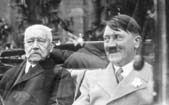

The Weimar Republic was a democracy and so the Nazis had to campaign for votes as any other party in any other democracy. In the late 1920s the Nazi party gained more and more seats. In the July 1932 general election, the Nazi party polled 37.3% and became the largest party. Hitler was still not invited to create a government, but six months later, although his popularity had dropped to 33%, President von Hindenburg appointed him Chancellor of the Weimar Republic. This gave Hitler the opportunity he wanted.



| |
|
|
|
|
|
|
|
|
|